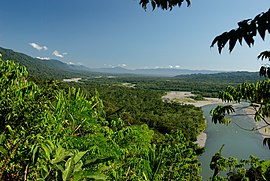This article needs additional citations for verification. (January 2011) |
Madre de Dios
Departamento de Madre de Dios (Spanish) | |
|---|---|
 | |
 Location of the department of Madre de Dios in Peru | |
| Coordinates: 11°59′S 70°35′W / 11.99°S 70.59°W | |
| Country | Peru |
| Subdivisions | 3 provinces and 11 districts |
| Capital | Puerto Maldonado |
| Government | |
| • Governor | Luis Hidalgo Okimura (2019–2022) |
| Area | |
• Total | 85,300.54 km2 (32,934.72 sq mi) |
| Highest elevation | 3,932 m (12,900 ft) |
| Lowest elevation | 183 m (600 ft) |
| Population (2017) | |
• Total | 141,070 |
| • Density | 1.7/km2 (4.3/sq mi) |
| UBIGEO | 17 |
| Dialing code | 082 |
| ISO 3166 code | PE-MDD |
| Principal resources | Cotton, coffee, sugar cane, cacao beans, Brazil nuts, palm oil, gold, rice, coconut, wood. |
| Poverty rate | 36.7% |
| Percentage of Peru's GDP | 0.37% |
| Website | www.regionmadrededios.gob.pe |
Madre de Dios (Spanish pronunciation: [ˈmaðɾe ðe ˈðjos] , English: Mother of God) is a department and region in southeastern Peru, bordering Brazil, Bolivia and the Peruvian departments of Puno, Cusco and Ucayali, in the Amazon Basin. Its capital is the city of Puerto Maldonado. It is also the third largest department in Peru, after Ucayali and Loreto. However, it is also the least densely populated department in Peru, as well as its least populous department. It has one of the lowest poverty rates in Peru.
The name of the department is derived from the Madre de Dios River, ultimately a tributary of the Amazon, and named by ethnic Spanish colonists. It is a very common Spanish language designation for the Virgin Mary, literally meaning Mother of God.

